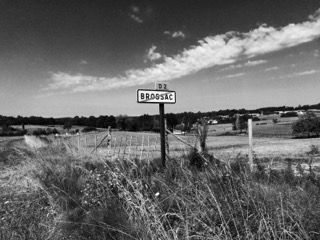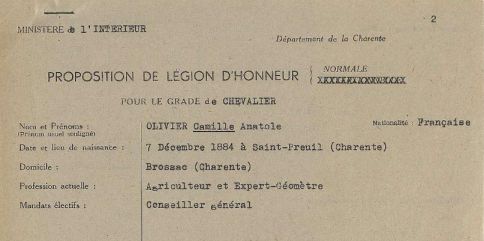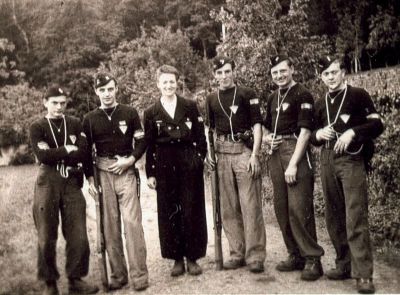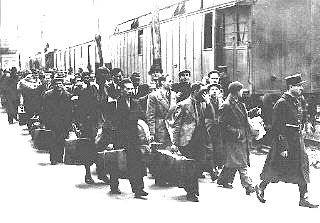|
|

Brossac
Village
|
|
Brossac village has all one needs to compliment
a
stay in The Southwest of France
Brossac
History
|
The
Charente During WWII
Following the German invasion of
France in May of 1940 and the
subsequent split of the nation into so-called ‘free’ and ‘occupied’
zones, the region of Charente was cut in two by the demarcation line,
which ran straight through Vienne, Charente, Dordogne, Gironde, and the
Basses-Pyrénées. Of the five administrative regions of occupied France,
Brossac and the rest of the occupied Charente fell into Région B, which
had its German headquarters at Angers.

In
1942, in retaliation for the Allied campaign Operation Torch in North
Africa, French and Italian forces invaded and occupied the so-called
‘free zones,’ reuniting all of France - and the two zones of the
Charente - under a Nazi dictatorship until liberation by Allied forces
in 1944.
|
Person
of Interest: Camille Olivier
Camille Anatole Olivier (born 7 Dec.
1884) was the mayor of the canton of Brossac from 1935-1940, and also
held the position of Conseiller Général of the Charente from 1934-1940
and again from 1945-1964. His first term for both positions was
interrupted by a Nazi crackdown in the German Charente from 1940 until
the end of the war, during which the positions of mayor and
Conseiller Général were eliminated following a series of
push-backs from the French Resistance in the region. Though Brossac had
been under German control since June, local management had been allowed
to remain, and it was not until after the August rebellions that the
German High Command became the sole administrator of the region.

Olivier,
however, was no stranger to war - he had served in the First World War
from 1915 to 1918, and retained close ties to the French military and
government throughout the remainder of his life. Before commencing his
political career in 1925 (at which point he became the Conseiller
d'Arrondissement of Charente), Olivier studied Agriculture and Geometry
and became an agriculturalist on his farm in Brossac. In 1950, he was
was made a Chevalier in the Légion d’Honneur for his work for the
people of the Charente (and of Brossac in particular - it is referred
to as his ‘petite partie charentaise’ in the official report), and in
1958 he made the rank of Officier. (Click here to
read more about the Légion d’Honneur).
After
the war, Olivier resumed his position as Conseiller Général of
Charente, and by all accounts continued to serve the people of Brossac
and all of the Charente wholeheartedly.
Click
here for Olivier's official documents
|
Group
of Interest: La Résistance in Chalais
The
main resistance movement in the Charente during the war were the Maquis
- rural bands of guerilla fighters that served as a liaison between
different resistance groups such as the Resistance Fer (railway
employees) and the Resistance de Sapeurs Pompiers (firefighters) in the
South of France. While Claude Bonnier was in charge of training
resistance fighters in the whole of South-West of France, Jacques
Nantes was the man delegated to train saboteurs in the
Charente, Charente-Maritime, and Bordeaux. The Maquis in Chalais were
especially famed for one insurgency in particular which played out in
early September of 1940, about two months after German occupation.
The
Chalais Maquis' claim to fame centered around their prolific cutting
of German telephone lines in the region, much to the annoyance of the
Germans. Following an especially damaging stint on the 26th of
August, Colonel Kretschmann of the Nazi Army issued a
statement
promising to ‘encore une fois prendre des sanctions contre les communes
et leur population’ - implement further sanctions on the population of
Charente (which, as it turned out, included the elimination of the
positions of mayor and Conseiller Général, putting Camille Olivier out
of a job). Any further vandalizing of German communications,
Kretschmann decreed, was outlawed ‘sous peine de mort’ (under
pain of death).

On
August 28th, Alfred Ferrand, a Maquisard of Chalais, was beaten
by
German police for his participation in the August 26th operation and
was found by his comrades on the road between Rue La Petitie and Rue
Bouex. Ferrand, sadly, died in hospital from his wounds,
inciting intense anger in Maquis circles. Then, five days later,
another Maquis member by the name of Jean Ratouit was found beaten and
left out in his fields at Chez Grosiac to die. Resentment in the
Chalais Maquis reached its height. In early September, a new wave
of cutting of communications took place, spurred by a desire to avenge
the death of Ferrand and the beating of Ratouit.
The
Germans, of course, were furious - with the help of the French police,
an investigation was immediately launched into the operations of the
Chalais Maquis, which proved surprisingly fruitless. Did the French
police willingly turn a blind eye to the operations of Maquis, as a way
of quietly rebelling against their German overlords? Or were the
Chalais Maquis just particularly skilled in covering their tracks?
Though we’ll never know for sure, the legend of the Maquis Chalais
serves as a great testament to the people of this small region, and is
one of the many inspiring stories of civilian resistance in the Second
World War.
|
Event
of Interest: Jewish Raids in the Charente and Limousin
Following
the formulation and fine-tuning of the Nazi’s ‘Final Solution to the
Jewish Question’ at the Wannsee Conference in January 1942, a number of
Jewish raids took place in the Charente and the neighboring region of
Limousin, which is about 30 minutes away from Brossac by car. According
to the AJPN (L’Organisation pour les Anonymes, Justes et Persécutés
durant la période Nazie dans les communes de France), these raids were
carried out by local German police forces under the command of the
Regional Prefects (Préfets Régionaux) of the Charente and Limousin
regions. From a police report sent by the General Secretary of Limoges
police force (a town about two hours from Brossac), we discover that
certain categories of Jewish people were in fact exempt from these raid
orders - specifically, pregnant women, people over 60, and
unaccompanied minors.
The
Limousin raid took place on 26th of August 1942 and resulted in
the
capture and deportation of 446 Jews, 68 of whom were children. The
captives were transported to a camp in Nexon, a town about half an hour
south of Limoges, where they were then boarded onto transport headed
for the town of Drancy (near Paris) three days later. From there,
according to AJPN records, the detainees were then boarded onto
convoyes labelled numbers 26 and 27, heading straight for Auschwitz.

A
little over a month later, on the nights of October 8th and 9th,
two more Jewish raids took place in the Charente. While the AJPN
unfortunately has no records for the number of people deported in these
raids, we can be sure that it devastated the lives of numerous
Charentais, leaving deep scars in the region for years to come.
|
This article was researched and written by Aina Swartz a volunteer at La Giraudiere who was from the USA
References for this article.
Websites:
http://memorial16.free.fr/anglais/occupation.htm#res1
http://www.ajpn.org/commune-Brossac-16066.html
http://www.map-france.com/Brossac-16480/
https://en.wikipedia.org/wiki/German_military_administration_in_occupied_France_during_World_War_II#Occupation_zones
http://www.parolesderesistants.com/
Books:
Jacques Baudet et Hugues Marquis, La Charente en Guerre (1939-1945)
H. R. Kedward, In
Search of the Maquis: Rural Resistance in Southern France |
This
website was produced by volunteers and interns from La
Giraudiere. To read more about their contribution and how this
subdomain was created, please visit Brossac Website
Creators you will also find a link to our Site Map
and our contact
information

|
|
|